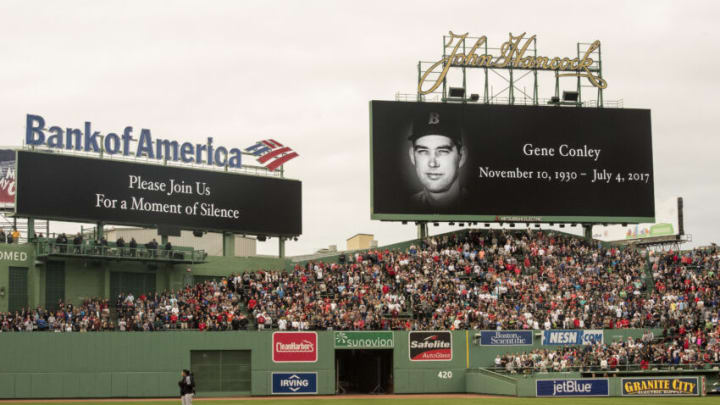Gene Conley played for the Red Sox, Braves, and Celtics.
Boston is in a frenzy with the Red Sox on a hot streak and the Celtics gunning for their 18th championship. There is a connector between the two with a member of the Cherokee Nation who played for both. Not only that, the connection goes deeper as Gene Conley also played for the Boston Braves.
Conley, an Oklahoma native, was an outstanding basketball player and pitcher for Washington State. Conley eventually signed with the Braves in 1950, and his dual-sport career began.
In April of 1952, Conley got the call, and the righty came to Boston to pitch – or be hammered back to the minors would be more appropriate. That April, good news was also to compensate for a wretched MLB beginning – the Boston Celtics drafted Conley.
Conley played 39 games for the C’s in 1952-1953, and that would be it for basketball until 1958-1959 as Conley concentrated on baseball. In 1954, the Braves were now in Milwaukee, and Conley was now an All-Star going 14-9. Conley was also the winning pitcher in the 1955 All-Star game the following season.
In 1957, the Braves defeated the Yankees – a glorious moment for this former Braves fan – in the World Series. Conley went 9-9 that season and, in a few years, was traded to the Phillies, where he again became an All-Star. But basketball was still in the picture.
Conley joined the Celtics for the 1958-1959 season for a three-year run primarily as the backup center for Bill Russell. Three years and three championships, but the dual-task was made easier by a trade from Philadelphia to the Boston Red Sox in the 1959 offseason.
The Red Sox shipped righty Frank Sullivan (6’7″) for Conley (6’8″), which led to a great line by baseball iconoclast Frank “Trader” Lane when quizzed about the deal. Lane responded, “The Red Sox got the better by one inch.”
Conley was not a great pitcher but a competent one. In three seasons with the Red Sox, Conley went 29-32 with a 4.57 ERA. Considering the quality of the product on the field was not outstanding, Conley did a respectable job. What I remember most about Conley are two things. The first is an extension with his ultra-long arms, much like future Celtic Kevin McHale.
The second was his hitting. Conley loved to pump out home runs over The Monster in batting practice, and it was not lost in the game. He finished his career with five home runs and a .195 batting average. Conley was also an excellent fielder – quite intuitive and quick.
Conley was also the centerpiece of one of the more quirky memories in Red Sox history. The team bus was stuck in New York City traffic, and Conley and teammate Pumpsie Green left to find a restroom. The restroom was in a bar, and when the players returned, the bus was long gone. Green returned to the team the next day, but Conley was intent on flying to Jerusalem. Sanity returned, as did Conley, and he was fined.
Conley’s last season on the mound was in 1963 (3-4, 6.64), as a chronic shoulder injury ended his hardball career. Still, basketball was in the picture for Conley, who had sat out the 1961-1962 season after being selected by Chicago in the expansion draft. Conley was traded to the Knicks, where he played for two seasons before returning to the dreaded private sector in the Boston area and a successful post-basketball career. Conley played in 351 NBA games producing a 5.9 PPG. Conley died of heart failure at age-86.
Professional baseball and basketball have had several dual performers, such as Dick Groat. Groat played 26 NBA games averaging 16.8 points, but in baseball, Groat played 14 seasons, winning the National League MVP in 1960.
Dave DeBusschere had a career 3-4 record for the White Sox, but as a Detroit Piston/New York Knick, he became an eight-time All-Star, six-time all-defensive team, two-time NBA champion, commissioner of the ABA, and is a member of the Basketball Hall of Fame.
Cotton Nash played just 13 games at the MLB level and 84 games in the NBA. Lefty Steve Hamilton pitched 12 years in the majors and appeared in 82 games for the Minneapolis Lakers. Fellow lefty Mark Hendrickson played for five NBA teams averaging 3.3 PPG. Hendrickson also played for five MLB teams winning 54 games.
Ron Reed pitched for 19 years capturing 146 wins, but in the NBA, Reed played two seasons with Detroit averaging 8.0 PPG. Dick Ricketts, Danny Ainge, and actor Chuck Connors are part of the list, and I may have missed a few, but Conley stands out as equally good in both sports.
